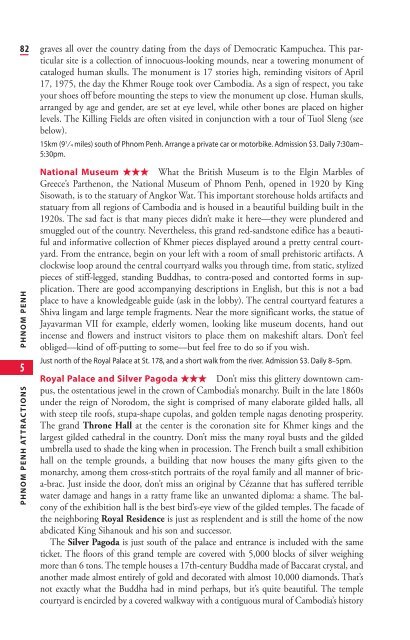You also want an ePaper? Increase the reach of your titles
YUMPU automatically turns print PDFs into web optimized ePapers that Google loves.
82<br />
PHNOM PENH<br />
5<br />
PHNOM PENH ATTRACTIONS<br />
graves all over the country dating from the days <strong>of</strong> Democratic Kampuchea. This particular<br />
site is a collection <strong>of</strong> innocuous-looking mounds, near a towering monument <strong>of</strong><br />
cataloged human skulls. <strong>The</strong> monument is 17 stories high, reminding visitors <strong>of</strong> April<br />
17, 1975, the day the Khmer Rouge took over <strong>Cambodia</strong>. As a sign <strong>of</strong> respect, you take<br />
your shoes <strong>of</strong>f before mounting the steps to view the monument up close. Human skulls,<br />
arranged by age and gender, are set at eye level, while other bones are placed on higher<br />
levels. <strong>The</strong> Killing Fields are <strong>of</strong>ten visited in conjunction with a tour <strong>of</strong> Tuol Sleng (see<br />
below).<br />
15km (91 ⁄4 miles) south <strong>of</strong> Phnom Penh. Arrange a private car or motorbike. Admission $3. Daily 7:30am–<br />
5:30pm.<br />
National Museum What the British Museum is to the Elgin Marbles <strong>of</strong><br />
Greece’s Parthenon, the National Museum <strong>of</strong> Phnom Penh, opened in 1920 by King<br />
Sisowath, is to the statuary <strong>of</strong> Angkor Wat. This important storehouse holds artifacts and<br />
statuary from all regions <strong>of</strong> <strong>Cambodia</strong> and is housed in a beautiful building built in the<br />
1920s. <strong>The</strong> sad fact is that many pieces didn’t make it here—they were plundered and<br />
smuggled out <strong>of</strong> the country. Nevertheless, this grand red-sandstone edifice has a beautiful<br />
and informative collection <strong>of</strong> Khmer pieces displayed around a pretty central courtyard.<br />
From the entrance, begin on your left with a room <strong>of</strong> small prehistoric artifacts. A<br />
clockwise loop around the central courtyard walks you through time, from static, stylized<br />
pieces <strong>of</strong> stiff-legged, standing Buddhas, to contra-posed and contorted forms in supplication.<br />
<strong>The</strong>re are good accompanying descriptions in English, but this is not a bad<br />
place to have a knowledgeable guide (ask in the lobby). <strong>The</strong> central courtyard features a<br />
Shiva lingam and large temple fragments. Near the more significant works, the statue <strong>of</strong><br />
Jayavarman VII for example, elderly women, looking like museum docents, hand out<br />
incense and flowers and instruct visitors to place them on makeshift altars. Don’t feel<br />
obliged—kind <strong>of</strong> <strong>of</strong>f-putting to some—but feel free to do so if you wish.<br />
Just north <strong>of</strong> the Royal Palace at St. 178, and a short walk from the river. Admission $3. Daily 8–5pm.<br />
Royal Palace and Silver Pagoda Don’t miss this glittery downtown campus,<br />
the ostentatious jewel in the crown <strong>of</strong> <strong>Cambodia</strong>’s monarchy. Built in the late 1860s<br />
under the reign <strong>of</strong> Norodom, the sight is comprised <strong>of</strong> many elaborate gilded halls, all<br />
with steep tile ro<strong>of</strong>s, stupa-shape cupolas, and golden temple nagas denoting prosperity.<br />
<strong>The</strong> grand Throne Hall at the center is the coronation site for Khmer kings and the<br />
largest gilded cathedral in the country. Don’t miss the many royal busts and the gilded<br />
umbrella used to shade the king when in procession. <strong>The</strong> French built a small exhibition<br />
hall on the temple grounds, a building that now houses the many gifts given to the<br />
monarchy, among them cross-stitch portraits <strong>of</strong> the royal family and all manner <strong>of</strong> brica-brac.<br />
Just inside the door, don’t miss an original by Cézanne that has suffered terrible<br />
water damage and hangs in a ratty frame like an unwanted diploma: a shame. <strong>The</strong> balcony<br />
<strong>of</strong> the exhibition hall is the best bird’s-eye view <strong>of</strong> the gilded temples. <strong>The</strong> facade <strong>of</strong><br />
the neighboring Royal Residence is just as resplendent and is still the home <strong>of</strong> the now<br />
abdicated King Sihanouk and his son and successor.<br />
<strong>The</strong> Silver Pagoda is just south <strong>of</strong> the palace and entrance is included with the same<br />
ticket. <strong>The</strong> floors <strong>of</strong> this grand temple are covered with 5,000 blocks <strong>of</strong> silver weighing<br />
more than 6 tons. <strong>The</strong> temple houses a 17th-century Buddha made <strong>of</strong> Baccarat crystal, and<br />
another made almost entirely <strong>of</strong> gold and decorated with almost 10,000 diamonds. That’s<br />
not exactly what the Buddha had in mind perhaps, but it’s quite beautiful. <strong>The</strong> temple<br />
courtyard is encircled by a covered walkway with a contiguous mural <strong>of</strong> <strong>Cambodia</strong>’s history










